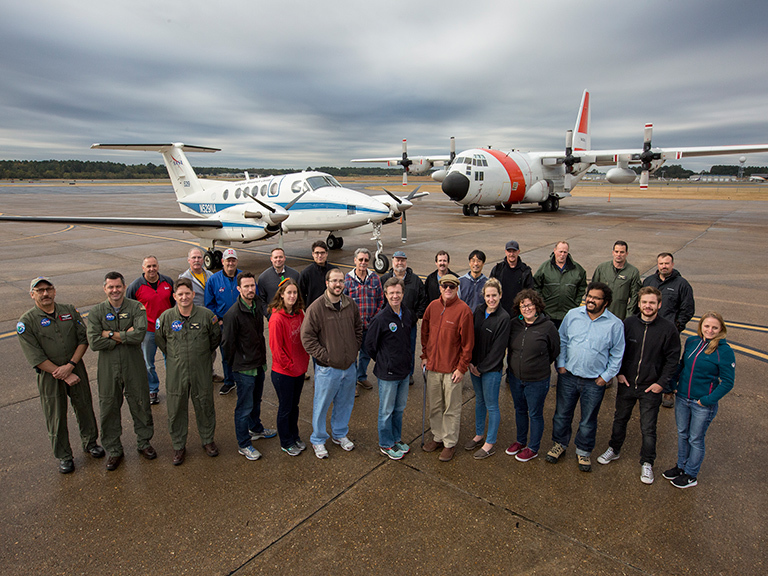Ask NASA Climate | November 3, 2017, 07:12 PDT
ACT-America: Waiting for the great big teaspoon in the sky

ACT America group with the B200 King Air and C130 Hercules in Shreveport, Louisiana. Credit: NASA/David C. Bowman.
Brrrr.
I don’t know what I was expecting from Louisiana in late October, but I definitely wasn’t expecting cold and damp.
I’m here for the final leg of the fall 2017 flight campaign for Atmospheric Carbon and Transport-America, or ACT-America, a five-year NASA study looking at the transport of carbon dioxide and methane by weather systems in the eastern United States.
This is the third flight campaign of the study and the team has just arrived in Shreveport—home base for the next two weeks. Flight operations will be based out of Shreveport Regional Airport. Sleep operations are based at a hotel just a few minutes down the road in Bossier City.
As I’ve already mentioned, the weather so far is pretty meh. There’s a slow-moving front to thank for that. But more on the creeping front later on. First, a little taste of ACT-America’s home for the next couple of weeks.
Shreveport is the largest city in Ark-La-Tex, a region that includes Northwestern Louisiana, Northeastern Texas and South Arkansas. It and Bossier City are divided by the Red River. Shreveport is on the west, Bossier City the east. Casinos dot the riverbank—the Horseshoe, Boomtown, Eldorado, Margaritaville, Diamond Jack’s.
It’s no big surprise that you can’t go far here without finding restaurants that have Cajun and Creole dishes on the menu. The first night in town, a contingent from the ACT-America team visits the Blind Tiger in downtown Shreveport. Steaming plates of crawfish etouffe come out of the kitchen accompanied by crusty homemade croutons and mounds of rice. There’s a dish called Cajun fried corn—breaded, deep-fried corn on the cob. Louisiana beers are on tap. Gumbo is spelled gumbeaux.
The State Fair of Louisiana is taking place in Shreveport. It claims to be the largest livestock show and carnival in the state. Rick Rowe, a reporter with the local ABC affiliate, does a segment on the morning news with a man who sells fried cheese at the fair. Rowe samples a cube that’s just been pulled from the bubbling hot oil and sounds positively ecstatic as he bites through the crispy breading.
The state fair isn’t the only thing going on, though. Another news segment has a meteorologist visiting a Bossier City shop that sells power equipment: lawnmowers, leaf blowers, generators, chainsaws. They have an event coming up called Sawdust Days. Folks who show up for Sawdust Days will be treated to a special demonstration by a man who does wood carvings with a chainsaw.
“He’s carved a lot of pieces right here,” the shop owner says, gesturing to a rustic-looking wooden bear that towers over him and the meteorologist, “so he’s pretty good at it.”
I turn off the TV and head to the airport to catch up with another guy who knows something about meteorology—Ken Davis, principal investigator for ACT-America and a professor of meteorology at Penn State University.
Weather is critical to ACT-America. In fact, it’s the reason that, on its first full day in Shreveport, the campaign is keeping its C-130 and B200 aircraft on the ground. Just the day before, as ACT-America moved from its previous home base in Lincoln, Nebraska, to Shreveport, the aircraft passed through the very front that’s inching through Louisiana now, bringing the chilly air and rain along with it. Instruments on both aircraft measured carbon dioxide and methane levels during the transit.
“This weather is relatively similar to what we documented yesterday,” Davis says. “If we measured it yesterday, we don’t need to measure it today.”
What the team will want to measure, though, is what happens to the greenhouse gases after the cold front stalls not too far south of Shreveport. There, it’ll get a push from warm, low-level air flowing in from the Gulf of Mexico and then move northeast as a warm front.
It’s a scenario that may take a couple of days to play out, so the next research flights may happen tomorrow, they may happen the day after tomorrow. The atmosphere will do what it wants to do, thank you. Davis likens it to a big cup of coffee.
“Over the timescale of days,” he stretches out days when he says it, “somebody’s stirring it with a great big teaspoon. And you’ve got to wait … every stir takes a couple of days. We want to measure different parts of that.”
Later on, at a planning meeting, they make the final decision—another down day tomorrow, then a flight the next day when the great big teaspoon in the sky has finally mixed things up just so. It’ll be a good day for airborne science.
The meeting breaks up. Folks head back to their hotel rooms.
With a free evening in front of me, I think about taking a chilly walk down the bank of the Red River to get a look at the Shreveport skyline at night. And for some reason, I’m craving a piping hot cup of coffee.
This piece was originally published on the NASA Earth Expeditions blog.
